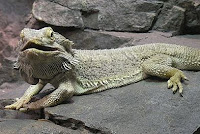There are a lot of myths slipping around about snakes. There are also a lot of interesting facts that you may not know. If you are interested in keeping snakes as exotic pets, you will be interested in knowing a few facts to better understand these reptiles. Some of them might surprise you.
Reptiles are tetrapods; that is, creatures that have four limbs or have ancestors that had four limbs. Snakes fit the latter description.
Humans have four chambers in their hearts, but most
reptiles have three. Some snakes, however, have the ability to contract their heart so that they have four chambers. Pythons are one of those.
Pythons also have a sensor that detects infrared thermal radiation. This helps them detect other predators and prey so they can hunt for food in the dark. It is also believed to help them with thermoregulation, the process of regulating one's body temperature. This sensor is located in the area that would appear to be the tip of the nose.
FACTOID: Snakes are not technically poisonous, but venomous. The difference is in the way the toxin is taken into the body. Poisons are effective when they are eaten, breathed or touched. Venom has to be injected, hence the fangs on a snake. Next time you want to show off at a party, tell your friends that rattlesnakes are not poisonous. After they call you out, explain your newfound knowledge.
A popular myth about snakes is that they are slimy. Other reptiles get this rap, too. However, this is not true unless they have been in something slimy. In fact, they do not have the ability to make themselves slimy because they have no sweat glands. If you were to pick one up, you would find them to be quite dry and even somewhat leathery feeling.
Snakes do shed, so if you keep pet snakes, you need to provide plenty of humidity for them to help them shed. A
humid hide for reptiles can assist with that. Younger snakes will shed several times per year as they outgrow their skin. Older snakes shed less often because they are not growing as fast. They may shed as seldom as once or twice per year.
The world's longest snake species is the reticulated python, which was recorded at 33 feet. Most of them, however, get to be around 20 feet. Other reports have recorded a 28-foot anaconda, and as far as weight goes, that species is probably the heaviest and can weigh hundreds of pounds. One was reported in 1978 by a geologist to be over 24 feet long and weigh between 300 and 400 pounds.
INTERESTING FACT: The hognose snake, which is found in North and South America and northern Mexico, has an upturned snout like that of a pig. But that is not the most interesting thing: If they feel threatened, they will play dead. They do this by rolling over on their backs and lying still with their tongue hanging out of their mouth. They are even able to generate drops of blood on their tongue to sell the fake out. If the predator moves them out of that position, the hognose will immediately assume it again in another effort to sell it.
If you do take an interest in owning a snake, you have to decide if you want a small one, like a garter snake, or a larger one like a python. If you choose to go with the latter, you will need a very large housing for it - very large; even closet sized. So, be prepared for that. Also, be prepared to keep it for a long time because they can live over 20 years - even up to 50. That's quite a commitment, so if you're not prepared for that, try a gecko or something that only lives about 10 years or so.




